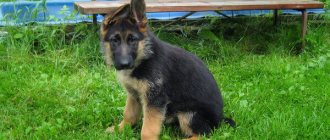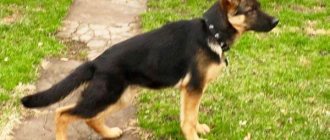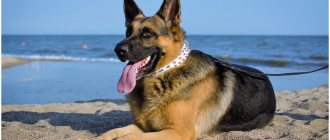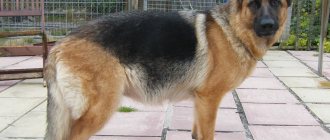The German Shepherd is called a symbol of bravery and courage. This dog is a faithful and at the same time dangerous friend of man. The character of the beast depends on its upbringing. If you are accustomed to affection and patience, your pet will become your most devoted and beloved friend. This breed is also easy to train. It will take a lot of patience to shelter this four-legged friend. He needs special care. An aspect of dog care is the question: What do German Shepherds eat? Not only friendliness, but also health depends on it.
German Shepherd nutrition, how and what to feed
The main rule that you need to learn when feeding your German Shepherd: the dog should not overeat. This point becomes especially important if the pet is active and jumps and runs a lot after eating. There are many side effects from eating too much. For example, obesity or atherosclerosis may begin, and your health will be unimportant.
The dangerous problem is that this breed is more prone to volvulus than others. Scientists zoologists explain this by the fact that the stomach organ in the body of the four-legged friend is too loose, it does not have precise attachment and is always in a “state of flight”.
For the health of the German Shepherd, it is important to establish the feeding process. To properly establish feeding, it is enough to follow a number of rules:
- eating at the same time every day;
- Food should be given only after the pet has taken a walk;
- if the dog has not had lunch 30–40 minutes after the walk, then it should be separated from the bowl until the next scheduled meal;
- choose one product and feed it every day, and introduce the remaining products into the diet gradually and intermittently, as additional nutrition.
Which ones are better not to give?
Despite the fact that cereals can make up up to 40% of the diet, not all cereals can be given to a puppy.
It is better to refrain from feeding your dog:
- manna;
- corn;
- pearl barley;
- pea porridge.
These types of dishes have virtually no nutritional value and are poorly filling.
Veterinarians note that feeding a shepherd dog with such cereals can provoke distension of the stomach and, as a result, cause digestive upset or gastric volvulus - a rapidly developing pathology that requires immediate surgical intervention.
Important! Your dog's diet should not contain foods that could be harmful to its health. These include sweets, chicken and other small, sharp bones, and fatty meats.
Puppy diet
When a small German Shepherd puppy comes into the family, the owners are puzzled by the question of what the baby eats and what to feed the Shepherd puppy?
There is a difference in the nutrition of a small puppy and an adult.
If we are talking about a newly born puppy, then the main food for him will be mother's milk. It will attach itself to the mammary glands of a nursing dog 10–12 times a day.
It happens that the mother cannot feed the newborn for various reasons, then the owner will have to personally feed him from a pipette.
Mother's milk can be replaced with cow's or goat's milk, and it must be given through a pipette or bottle for newborns. The volume of milk should not exceed 2/3 cup daily, and the food temperature should not exceed 27 degrees.
When puppies reach two months of age, they need to receive all the important vitamins and minerals for healthy growth and development. It is important to control the intake of calcium into the baby’s body. Its excess can negatively affect health.
You also need to monitor your weight gain. The normal weight for a puppy is no more than 60% of the weight of an adult dog.
Natural nutrition should prevail in the diet; if the owner decides to switch the puppy to food or use a mixed diet, then it is necessary to choose food that has a certificate of the highest quality and is approved by leading veterinarians.
Natural feed rate
From the point of view of digestion, the optimal consistency of the food is the same as that of porridge, that is. Manufacturers of canned goods are guided by this provision. To approximately determine the amount of natural food for a puppy, take the data from the table on dry food rationing and multiply by 3. The data is shown in the table:
| Age, months | Average live weight, kg | Live weight of an adult dog, kg | |||
| 27 | 32 | 37 | 42 | ||
| 2 | 7,5 | 690 | 725 | 790 | 860 |
| 3 | 13 | 850 | 920 | 1025 | 1130 |
| 4 | 18 | 940 | 1040 | 1150 | 1245 |
| 6 | 27 | 1140 | 1280 | 1425 | 1550 |
| 8 | 29 | 1140 | 1290 | 1430 | 1560 |
| 10 | 33 | 1130 | 1290 | 1440 | 1560 |
Needs and preferences are individual. Therefore, make sure that your pet eats the food completely. Keep in mind that heat reduces consumption, and cold increases it. A dog is a more perfect creature than a human. She knows how to heat herself from the inside.
Features of feeding a puppy with natural products
When the owner weans the puppy from its mother's milk, he must decide what kind of food he will offer the animal in the future: natural or dry.
If the choice fell on natural food, then you should remember a number of rules for introducing complementary foods:
- the main thing is to gradually reduce the amount of milk consumed and introduce new products into the diet;
- you can start with milk porridge, boiled meat or boiled vegetables;
- It is allowed to feed the puppy both dry and natural food at the same time, the main thing is not to mix them at one time.
The number of servings at 3 months is 3-4 glasses of food, which should be given 5 times a day. When the pet reaches 6 months, it will need 1.5 liters of food 3 times a day.
How much to give?
Now that we have decided on the cereals, let’s calculate how much cereal to give the dog at one feeding? The main dish is porridge with meat products and vegetables, given to pets at the rate of 60-70 grams. feed per 1 kilogram of body weight per day
. This norm is divided into 2 or 3 doses.
A book about dogs (Roucerol Georges V.)
The proportions of the products are as follows:
50% stringy meat and offal; 30% porridge; 20% vegetables and fruits. Thus, per kilogram of dog weight, you need 30-35 grams of meat, 20-25 grams of porridge, and 5-10 grams of vegetables and herbs per day. A dog that weighs 15 kg should eat 150-190 grams with two meals a day. porridge for one feeding or 300-375 gr. in a day.
Rules for feeding a puppy dry food
When choosing dry food, you need to take into account the puppy’s age and taste preferences. To select the correct diet, the owner is recommended to visit a veterinarian with the pet. He will choose the right food. The food must meet quality standards and have special certificates confirming its benefits.
Food should be introduced gradually into the diet of a small puppy. First, it is recommended to soak the food in water until it becomes a paste.
At 6-10 months, the puppy can eat 1 full serving of food 3-4 times a day.
Is it possible to add sugar to dog dishes? Do I need to add salt?
Sugar is a valuable product; the body can release a large amount of energy from it. But it is strictly contraindicated for dogs. Their liver and pancreas are capable of processing glucose, but in extremely small quantities. Excess will cause problems. Dandruff will appear and your eyes will start to run. Very often otitis of unknown etiology and redness of the ears appear. With constant use of sugar, it will begin to act as an allergen. But everything is individual.
The dog receives salt in sufficient quantities from food, provided that the owner provides it with a high-quality diet, whether it be a natural type of feeding or industrial food.
Salt plays an important role in the body's metabolism. The functioning of the heart, the secretion of gastric juice and the functioning of the gastrointestinal tract and nervous system depend on it.
If you add this product to your diet on your own, an overdose with negative consequences is likely. Chronic salt poisoning will lead to death. The lethal dose is 3 g per kilogram of body weight.
A constant excess of salt will lead to urolithiasis, gastrointestinal upset, and metabolic disorders.
With proper nutrition, the dog will receive the required amount of salt, which is contained in the foods it eats: Is porridge given to dogs extra salt? No.
Manna
Semolina is used for primary feeding of puppies, as well as for the treatment and prevention of dogs with gastrointestinal disorders and other diseases. The nutritional properties are unsatisfactory and as a main grain it is contraindicated.
Pearl barley
Pearl barley is not suitable as the main grain in the diet, since it is extremely poorly digestible and often comes out practically undigested. Its nutritional value is unsatisfactory. Even large and giant dogs do not digest it well. With constant feeding, gastrointestinal problems arise, including blockage. Especially if this cereal is not cooked.
Corn
Cannot be used as a staple in the diet. It contains a lot of protein - 3.27 g and fat - 1.35 per 100 g. Dogs will begin to gain weight quickly, this will lead to obesity. The musculoskeletal system will begin to fail. There will be a risk of joint dysplasia, and the spine may begin to sag. This is especially dangerous if the animal does not walk much and does not receive enough physical activity. This cereal is suitable only as an additive to stimulate growth - 10-15% of the diet.
From peas and legumes
None of these grains can be used either as the basis of a dog's diet or as a supplement. They are harmful. The consequence of their use is gastrointestinal upset, flatulence and colic. This occurs due to the fermentation processes that these products cause in the digestive tract.
Millet
When cooked poorly, cereals are poorly digestible and may come out almost unchanged. Can lead to gastrointestinal upset and blockage in case of constant feeding. But when cooked correctly, it is very nutritious - 385 calories. per 100 g. It is also hypoallergenic.
The principle of feeding an adult dog
The diet of an adult German Shepherd should include the following nutrients: carbohydrates, which help maintain the pet’s energy; proteins help maintain the tone of the dog’s entire body, and for vigor and good health it is necessary that vitamins enter the body along with food.
Currently, veterinarians do not have a clear answer as to what is the best way to feed your pet. Some people prefer dry food, while others believe that it is better for the animal to extract beneficial properties from food.
Feeding during illness
During illness, the animal needs careful care. What can you feed your shepherd dog during this period so that the lack of nutrients does not lead to further weakening of the body?
If the pet receives ready-made food, then it is transferred to special medicinal food. The basis of the diet of weakened animals is lean meat, fermented milk products, and vegetables. When the dog refuses to eat, you can prepare meat broths. Each case is individual and requires consultation with a veterinarian.
Feeding an adult dog natural food
If the owner prefers to feed his pet natural products, then he must adhere to several rules.
- All products must be of the highest quality;
- It is necessary to monitor expiration dates, especially for perishable products: meat or fermented milk dishes;
- Before cooking, you need to go through all stages of sanitation. If it is meat, then it needs to be washed and the veins removed. Fish meat should be removed from large bones;
- Food must be balanced and combine ingredients. For example, you should not combine meat intake with fruit.
When feeding natural products, a vitamin complex prescribed by a veterinarian must be added to the daily food diet.
Wheat
“Can dogs have wheat porridge?”
the answer is ambiguous, it is rich in vitamins C, E, A, B, phosphorus, calcium, but is inferior to the others. Not all owners use wheat cereal, because it is less digestible, so giving such a dish to a dog is risky. It should not be given to a puppy or small breed dogs. Large ones may rarely feed on it. It is necessary to cook the wheat until smooth, about 1 hour. Whether it is logical to give wheat to dogs is up to the owner to decide. There is no clear answer as to whether a dog can have wheat porridge; it is better to choose small portions and monitor the reaction.
Feeding an adult dog dry food
Feeding your pet dry food also has a number of advantages. For example, this type of food can be stored for a long time without losing its beneficial properties. You can take the food with you in a package. Many owners take it with them for a walk or when they go to visit. Even for a large pet, a small amount of food will be enough for one meal.
There are several types of feed. For example:
- the economy option provides a high fiber content, and also lacks important microelements and vitamins;
- The premium food category is of high quality. The composition contains a combination of meat and plant components, and the best varieties are called super premium. They are high in cost and it justifies itself. These foods are rich in vitamins and minerals. The highest class products are used for production. They can be purchased in specialized stores.
Diet preparation: cereals that can and cannot be given to your pet
Any breed needs proper nutrition throughout its life.
If for large breeds the diet can be varied and contain food from people, then for small breeds this is extremely contraindicated. A balanced diet that includes food, plant-based options, meat and healthy foods will help keep your pet healthy. It is important for the owner to know what cereals can be given to dogs and which ones can be harmful.
What to include in a natural diet
Natural food, of course, will be healthier than buying dry food. The main disadvantage is the large amount of time it takes to prepare natural food for your pet. The advantage is that German Shepherds do not require a varied diet, however, you need to monitor the quality of dog dishes and the presence of useful elements in them.
The main dish for a pet is meat. You can give your dog any kind of food except pork. Minced meat is prohibited because it is poorly digestible. Fish should also be present in your daily diet. It is important to ensure that the product does not contain large bones that could cause the animal to choke. It is possible to give eggs, mainly the yolk.
And German shepherds are delighted with fermented milk products. They will be happy to drink kefir, milk or fermented baked milk. You can include fruits and vegetables in your pet’s diet, depending on preferences. Some dogs enjoy eating grains. Their consumption also needs to be limited.
Cooking features
All grains must be washed before cooking.
To save time, you can cook porridge for your German Shepherd in a pressure cooker, which will not only quickly cook the cereal, but also retain the maximum amount of nutrients. When preparing porridge, you can also add vegetables cut into layers into the pressure cooker: carrots, pumpkin, beets.
Once the optimal cereals and suitable meat have been selected, you can prepare the porridge itself:
- First, boil the meat. It is better to put it in boiling water, then it will retain the maximum amount of nutrients and vitamins. It is better not to salt the water at all. Chicken necks cook the fastest; beef and pork will take longer (at least an hour).
- After cooking, the meat must be cooled and cut into small cubes. Large pieces of meat may not be digested if the dog is very hungry and attacks the food.
- The cereal is placed in already boiling water or broth; you can immediately add diced carrots - this vegetable will not lose its beneficial properties even after prolonged heat treatment.
- The porridge needs to be stirred constantly. It is important to remember that it takes longer to prepare for dogs than for humans.
- After cooking, the porridge for the German Shepherd should sit covered for half an hour.
When all the ingredients are ready, you just need to mix the meat with the porridge and give it to your pet.
Meat and offal
Meat is one of the most important components in the natural feeding of an adult shepherd dog. The most valuable is the muscle tissue of meat. It is she who works on myosin and actin, which are needed for the full development of the pet. These proteins are perfectly balanced in amino acid content. Connective tissues are less valued. Especially collagen and elastin. Meat also contains beneficial B vitamins, and it also contains vitamin E. Since meat is rich in protein, it can provide your pet with strength and energy.
Depending on the shepherd’s preferences, meat can be given either raw or boiled. It's very easy to prepare. It is enough to boil a whole piece in cold water and cut into square pieces. If we are talking about raw meat, then before serving it is necessary to rinse it well under running clean water. It is preferable to feed German Shepherds veal, beef, chicken or turkey. Pork is prohibited. It is also not recommended to feed your pet minced meat, as it is poorly absorbed in the body.
Cereals
A German Shepherd's diet may also include porridge. The technology for preparing cereals is typical. Usually the product is sifted or washed and then cooked until cooked. The best cereals for dogs are buckwheat and rice. They contain many useful elements, for example, buckwheat is rich in iron, and rice helps strengthen the digestive system and saturates the bird’s body with B vitamins. Oatmeal takes second place in the list of favorite cereals. It will be easy for your dog to eat porridge and at the same time receive a dose of unique amino acids, proteins and fats. To avoid allergies and make sure that the porridge has “taken root”, it is necessary to give one type for several days.
Many pets love an assortment of several types. There are oatmeal lovers. It must be introduced into the diet carefully. This porridge causes indigestion attacks in our four-legged friends more than others.
Cook porridge in water. If your German Shepherd refuses to eat, then you should try giving Hercules flakes, which you can simply add water and wait for them to swell.
Rice
To the question “Can a dog have rice?”
there is a clear answer - yes. It is rich in vitamins B, E, zinc, iron, magnesium. Everyone is fed rice. By adding meat or vegetables to the broth, porridge can be fed to an active four-legged animal that is not prone to obesity, but needs a large amount of calories. Is it possible to give rice if you are poisoned? It must be crumbly and contain mucus. This will cure diarrhea and remove toxins. Rice porridge is used as a stool fixative and an aid in stopping vomiting.
Steamed rice for dogs, as an anti-aging remedy, normalizes the functioning of the heart and blood vessels, bones and urinary system.
Whether dogs can have rice for several days in a row is up to the veterinarian to decide individually, since excessive consumption can lead to constipation.
Vegetables
An adult shepherd can be fed vegetables. The opinions of veterinarians are still divided. Some say that feeding your pet vegetables is not worth it and this has a bad effect on the functioning of the gastrointestinal tract. Others argue that if the pet does not object to this food and there are no negative consequences for a long time, then it is possible.
Vegetables themselves are rich in vitamins of various groups. Fruits also contain a large amount of pectin, which allows you to remove heavy metals from the body and get rid of excess cholesterol. Vegetables can be given to your pet either raw or boiled. You only need to exclude fried processing. Shepherds especially love stewed or boiled cabbage, raw carrots and boiled beets. If the owner prefers to give vegetables and make sure that the pet receives vitamins directly from the products, then he can grate the vegetables on a coarse grater and present his four-legged friend with a salad.
Menu for the week (table)
| Day of the week | Daily diet |
| Monday | Carrot salad with sour cream, rye croutons, beef, oatmeal, egg yolk |
| Tuesday | Curdled milk, light cookies, boiled liver, baked pumpkin |
| Wednesday | Ryazhenka, boiled fish, buckwheat porridge, vegetable oil, herbs |
| Thursday | Low-fat cheese, dried fruits, boiled chicken, cabbage and zucchini |
| Friday | Low-fat cottage cheese, boiled beef kidneys, buckwheat and carrots, apple |
| Saturday | Curdled milk, croutons, boiled veal heart, rice, rutabaga, greens |
| Sunday | Ryazhenka, apple, sunflower oil, oatmeal, zucchini stewed with carrots, tomatoes, herbs and butter, chicken necks |
Fish and seafood
In terms of its composition, fish is in no way inferior to meat in terms of the presence of nutrients. It contains a large amount of proteins, fats and mineral salts. There is especially a lot of phosphorus and iron in fish and seafood. Fish contains fluoride and is rich in iodine. Meotinin distinguishes the protein content of fish from meat. It is also customary to divide fish according to the amount of fat it contains. There are lean varieties, for example, pollock or cod; moderately fatty fish containing up to 3% fat (sprat, tuna) and fatty fish (mackerel, halibut). Fish oils burn out very quickly in the body and are very beneficial for the dog’s immunity. German Shepherds prefer seaweed when it comes to seafood. There are several thousand varieties of them. All of them are enriched with mineral salts and vitamins.
It is recommended to give your dog boiled fish.
Do I need salt?
The age-old question of all dog breeders is whether they need to add salt to their pet’s food. Every caring owner is concerned about how to diversify the dog’s food supply and how to please it. If your pet is happy to eat food with added salt and refuses bland food. Then, most likely, this is not spoilage, but a lack of salt in the body. Animals are very smart and know what is best for their body. But there are also pets who do not disdain salty sausage, and the owners will certainly pamper their pet.
Important! Excessive amounts of salt in a dog's food leads to its death!
Salt is important in a dog’s life, as it is responsible for hematopoiesis and promotes the secretion of gastric juice. Salt should be in the diet, but should not be tasted. If one piece does nothing, then four such pieces can lead to poisoning, kidney disease, and urinary tract diseases in the dog. Kidney stones and cystitis are a consequence of salty pet treats. If the dog regularly eats fresh meat, then it already contains as much salt as the body needs. When cooking meat, you should add 1/3 of the dose that you would add to yourself into the broth.
If you can't decide whether you need to add salt, think about how much treat comes from your table. For example, cheese, sausage, meat. If there is quite a lot, then you should not get carried away and add salt to your pet’s main food, because most of it has already been received with the treat.
Mmm, porridge with meat
It is well known that the dog must have fresh water in sufficient quantity
. It must be taken into account that if the pet consumes something additional that contains salt, it is necessary to increase the daily dose of salt.
Do not give or withhold salt to your dog thoughtlessly. It is necessary to consult a veterinarian, who will definitely prescribe a biochemical analysis. The results will make it clear whether salt can be added to the diet or whether it is completely contraindicated for the animal.
It is worth noting that when cooking porridge, you should add a little vegetable oil. This is very beneficial for the coat and eyes. You can add a little salt. Unless completely contraindicated by a veterinarian. This usually happens if the dog has kidney disease or urolithiasis.
Dairy products
Fermented milk products are enriched with all useful elements. There are minerals, fats, and proteins. German Shepherds prefer milk from all the fermented milk world. You can give goat, or you can give cow. It all depends on the pet’s taste choice.
These products also contain a certain amount of sugar, which is called milk sugar. It is not recommended to abuse it. Under the influence of lactic acid bacteria, lactose begins to ferment in the product and the result is kefir, yogurt, and fermented baked milk. They are also beneficial for your German Shepherd, just like milk. Lactic acid products are especially useful for puppies. Adult dogs should be given it with caution. The fact is that milk can cause stomach upset in four-legged friends. Then veterinarians advise switching to fermented milk products. There is a category of dairy-protein products, these include cottage cheese and cheese. This is the German Shepherd's favorite treat.
Bowl height
One bowl is enough for a dog. Veterinarians do not recommend purchasing plastic bowls. Preferably metal or ceramic. The volume of a bowl for a German Shepherd should be from 1.8 to 2.5 liters.
Important: feeding your German Shepherd from the floor is prohibited.
In order not to harm your pet, the bowl should be at chest level . If you do not provide a stand for the bowl, your pet will have problems with posture, paws and food poisoning. The retail chain has a wide variety of stands and tripods for bowls. The selection is individual according to the pet’s height.
How to choose dry food
If the owner loves and appreciates his pet, then he will feed him with middle or high-class varieties of dry food. These categories contain premium products, they are enriched with vitamins and minerals (which are not in the economy version), and most of them consist of meat. The food is literally full of protein. In economy class varieties, many low-quality manufacturers add a meat additive instead of meat, which is similar in taste, but no longer contains the nutrients that a dog needs to receive daily.
This food costs several times less than middle or high class food.
Important: you cannot save on the maintenance of animals; if a person has already taken responsibility for a German shepherd, then he must do everything for its health and well-being.
Recipes: how to cook?
We figured out what grains to cook porridge from. Let's move on to how to actually prepare tasty and healthy porridge:
With vegetables
- 1.5 cups of any porridge,
- 1 ripe tomato
- 1 medium carrot
- 1 medium potato,
- chicken soup set.
Pour water into the pan and throw in the chicken frames or heads. As soon as the water boils, add chopped carrots, potatoes and maybe a little cabbage. It boils a little - add the cereal.
If the dog likes it, you can add fresh herbs. As you know, greens are a whole bunch of vitamins. Place diced vegetables into the prepared warm wheat porridge. A wonderful summer meal for your pet is ready.
Important! Do not store this dish, but serve it freshly prepared so that the vegetables do not drain and retain all the vitamins.
Boil vegetables:
- Cauliflower
- Carrot
- Potato
- Parsley
- Spinach leaves
Add a glass of buckwheat to the vegetable broth and cook for 10-15 minutes. Then leave covered for 1 hour. When the soup is warm add 2 tablespoons of olive oil. A hearty, healthy soup is ready.
Dog rice
- 300 grams of any lean meat. You can have turkey, chicken.
- 2 cups cooked brown rice
- 1 cup cooked oatmeal
- 1 cup grated fresh carrots
- 1 cup diced vegetables (whatever your pet likes)
- 2 tablespoons olive oil
How to cook:
Cut the meat into pieces so that it is convenient for the dog to eat. This nutritious mixture of rice and vegetables will delight your pet either for breakfast or for dinner.
Hercules
Oatmeal is exactly what can serve as both a complete meal and a delicacy.
- 2 cups whole oatmeal
- 2 parts lean meat (chicken, beef),
- 1 grated carrot,
- 1 tbsp. olive oil.
Boil oatmeal, add pre-boiled meat until it becomes mucus. For your pet, this will be a fortified version of dinner or breakfast.
Combined nutrition
Combination nutrition is the combination of dry food with natural food. It is recommended to give different types of food at strictly defined times. This type of nutrition requires careful daily observation of the work of the shepherd’s digestion. Many owners consider this type of feeding very problematic and not justifiable. It is very difficult to determine which beneficial substances have entered the animal’s body and which have not.
Summary about dog nutrition
If you want your pet to be healthy and happy, you need to choose the right food. Homemade food should be supplemented with various vitamins, microelements and additives. Then the food will be useful and the animal will feel good. Cereals and porridges made from them are very important; many people do not know what cereals to feed their dog, and thus can harm it.
From a huge selection of products, you need to choose the one that will be useful for your animal. If prepared correctly and all proportions are observed, the food will be balanced and nutritious. And if you supplement your diet with good, high-quality meat and vegetables, your four-legged friend’s body will work without failure. By choosing only fresh foods and following your doctor's recommendations, you will ensure your pet has a happy and healthy life.
List of prohibited products
There are foods that you absolutely cannot feed your German Shepherd to avoid health problems. Here are the top most harmful foods for this dog:
- Garlic and onion. It should not be given either boiled or raw. If a significant amount of this product gets into your pet's food, it can cause poisoning. You can tell what a four-legged friend is like by his behavior - he will be lethargic and lazy.
- Chocolate. The caffeine contained in the product can be a deadly poison for a shepherd.
- Avocado. For comparison, an avocado is to a German Shepherd what a puffer fish is to a human.
- Boiled bone. The bone itself is not dangerous in its composition. But if your pet bites off a part and a splinter gets into his throat, then you need to sound the alarm and go to the veterinarian. Once in the intestines, such a fragment will not be digested and the animal will experience intestinal volvulus.
- Raw fish. This product will only become dangerous in its raw form. It can cause severe poisoning. When this happens, the dog will develop a fever and severe vomiting. If you do not seek help in time, death may occur.
- Liver. It should not be presented to the dog table too often. Since the liver contains vitamin A, this product can be dangerous for the skeletal system of four-legged animals. It is known that this vitamin cannot fully double in the body of a German Shepherd.
Methods of preparation and processing of products
To properly feed a German Shepherd, the owner should know how to prepare meals for the pet and what foods to combine.
Meat and offal
Beef, chicken, lamb and rabbit are cut into small pieces and fed raw to dogs. Pork should be boiled or scalded with boiling water. It is also advisable to boil offal, only the liver can be given raw.
Meat and offal are the main component of a shepherd's diet.
Porridge
Cereals are cooked in meat broth or water, since porridges cooked in milk cannot be given to adult animals, this leads to diarrhea. Porridge can be mixed with meat and vegetables.
Vegetables
They are offered to dogs raw, baked or boiled. Tomatoes must be peeled, otherwise it can clog the shepherd’s stomach and cause digestive problems.
Fish
It is advisable to boil the fish fillet and thoroughly remove the bones. Fish is given to dogs no more than twice a week.
Eggs
Eggs can be fed to dogs raw or boiled, but experts recommend feeding egg whites only raw. These products are introduced into the animal menu twice a week.
Raw egg can be added to porridge
All ingredients for dog food must be of high quality and fresh. Before cooking, fruits, vegetables, meat, fish and herbs are washed.
It is unacceptable to feed shepherds rotten and rotten foods or give them cottage cheese and kefir with an expired expiration date.
Vitamins
There are 2 large groups of vitamins that should enter the body of a German Shepherd every day. The first group is fat-soluble vitamins; they always accumulate in the body and are stored “in reserve.” This type includes vitamins A, D, E. The second category is water-soluble vitamins. They dissolve in the body every day, and if there is an excess, they are excreted in the urine. In total, 12 vitamins should enter the animal’s body, which will help normalize the body’s functioning. If a dog has a lack of vitamins, this will affect not only its health, but also its appearance. The fur will shed, the claws will break, for example.
How to avoid dog obesity
Overweight in a German Shepherd is a serious and fairly frequently diagnosed disease that occurs when there is no control over the amount of food consumed. Excessive fatness not only contributes to the deterioration of the aesthetic appearance of a four-legged pet, but also poses a serious threat to the health of the animal.
The main causes of obesity include overfeeding, lack of physical activity, metabolic disorders, stress, genetic predisposition or hormonal imbalance, and even worms.
It is not always possible to combat excess weight in a dog with diet or increased physical activity. The lack of effectiveness of dietary nutrition and physical activity may require the prescription of drug therapy. In this case, veterinarians most often recommend using the drug Dirlotaride (Slentrol), which suppresses the animal’s appetite and prevents the absorption of fats. The veterinary drug Yarvitin has a similar effect, reducing hunger and activating metabolic processes.
It should be remembered that medications are considered as a last resort and are prescribed only by a veterinarian after a complete examination of the dog and identification of the factors that provoked obesity.
Return to content
Age: 4-5 months
Starting from this period, the puppy needs to develop ligaments and joints. Also at this stage, teeth change, as a result of which the basis of the diet should be foods rich in calcium. The dog is still fed 4 times a day, keeping the serving size to 300-400 g.
- Changing teeth weakens the cartilage tissue, so your pet's ears may not rise. To promote full development, add collagen to your food. It can be found in confectionery gelatin or topical dietary supplements (for dogs).
- At four months of age, puppies are intensively developing their skeleton, in particular their posture. To help the body and lay the foundation for full development, gradually introduce chondoprotectors into your food. They are sold in pet stores, the main thing is to strictly follow the instructions and do not increase the quantity without permission. An alternative to the drug is Arthra, which can be purchased at a pharmacy.
- As for the basic nutrition, it remains the same (cottage cheese, meat, porridge, vegetables and fruits). However, now you need to feed the puppy not boiled meat, but beef tenderloin from the head. It contains a large amount of gelatin, which has a beneficial effect on the formation of the skeleton.
- You can prepare broth based on beef, veal, chicken, and then season meat porridge with it. But you shouldn’t make it too rich, so as not to burden the pancreas. The broth can be replaced with edible gelatin: dissolve it in water and stir into food (cottage cheese, porridge, mixed vegetables).
- To help speed up the replacement of baby teeth with molars, give your pet brain bones. It is also worth focusing on calcined additives marked “puppy”; pet stores sell a special series for German shepherds. If you have difficulty choosing, consult your veterinarian.
Age: 6-12 months
Once the puppy reaches six months of age, you can prepare porridge not only from pure meat, but also from offal (heart, liver, stomach). You should not give your dog thin bones; strong teeth will easily gnaw them, and the fragments will fall into the esophagus. Puppies 6-12 months old should have three meals a day, serving sizes vary from 350 to 450 g.
- At the same time, every month you need to reduce the amount of cottage cheese eaten for breakfast, and at the same time increase the amount of meat. If you are a cable owner, remove milk from your puppy's diet completely. In the case of females, the product is given daily.
- At this stage, the puppy’s owner needs to add active minerals, chondroprotectors, calcium and other vitamins, based on the weight and age of the pet. Don’t forget about vegetables and fruits; feed them to your puppy between main meals.
- To diversify your diet with cereals as much as possible, you can add buckwheat, millet, and millet to the existing rice and oatmeal. Combine them with each other, mix in raw or boiled meat/offal. Break a raw egg (sometimes a chicken egg can be replaced with a quail egg, doubling the quantity).
- It is allowed to give the puppy sea or river fish 2 times a week. However, these days you should not feed your pet meat. You should not overuse fish, as its composition destroys vitamin B in the dog’s body, which leads to digestive difficulties and stunted growth.
The basis of feeding a German Shepherd puppy is considered to be meat, cereals (except semolina), fresh or boiled vegetables and fruits. Don’t forget to pamper your pet with marrow bones, add food additives, gelatin, and calcium. Choose the right bowl and adjust the height of the stand. Follow a meal schedule, increase portions based on age, and walk more in the fresh air.
Choosing the right cookware
- First of all, you need to take care of your pet's bowl. It can be clay, metal, ceramic, plastic. The last option should be excluded; dishes of this kind fidget on the floor, not giving the pet the opportunity to eat normally.
- Small puppies often have loose legs, especially for those living in an apartment. Organize the feeding area based on the floor covering. If your home has laminate or linoleum, place a non-slip mat under your puppy's bowl. It can be fabric or silicone.
- It is known that at the age of up to one year, the puppy’s skeleton is just forming, as a result of which the frame is extremely fragile. For this reason, you need to place the bowl so that it is located at the level of your pet's neck or chest. Otherwise, during the period of growth, the puppy will constantly bend over, which will entail a curvature of the spine, a high raised croup, weak bones of the front legs and chest, problems with swallowing and digestive activity. You can adjust the height of the container using special stands, which are sold in all pet stores.
How to prepare milk porridge for a puppy?
To the question of how to cook porridge for puppies, the logical answer comes - using milk. For 1 liter of milk we take 6 tablespoons of semolina. We boil the milk. To prevent it from burning, first rinse the pan with ice water. Pour the cereal into the boiled milk, stirring constantly, in a thin stream. Puppies are not allowed to add salt or sugar to their porridge. Cool to room temperature, the product is ready. You can check your temperature by applying the mixture to the back of your wrist. If it doesn’t bake, then you can feed it to little ones.
If you want to cook buckwheat porridge, then the proportion will be 1 to 4 with milk, you need to cook for 35 minutes. over low heat. But this is food for older puppies. It is not suitable for first feeding.
Is it possible to give your dog raw meat?
Poultry meat is highly digestible and economical, but contains a large number of long bones that should not be given to dogs. Chicken meat may also contain salmonella pathogens and residual amounts of some antibiotics. Suitable for feeding to dogs that are not allergic to this type of protein.
Interesting materials:
How to turn on an electric stove correctly? How to stand on the bridge correctly? How to properly insert a bobbin into a sewing machine? How to introduce porridge correctly? How to enter a roundabout correctly? How to properly display goods in a clothing store? How to properly soak herring in milk? How to soak game properly? How to properly grow a ficus from a shoot? How to squeeze juice correctly?











